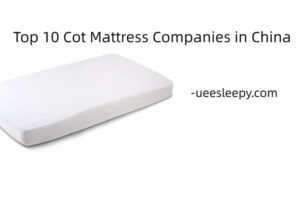In the ASTM D1566 standard, thermoplastic elastomers are defined as “rubber-like materials that, unlike conventional rubber, can be processed and recycled just like thermoplastics.” Injection molding, extrusion, and blow molding can all be used to process TPEs since they do not require curing or vulcanization during processing. In this article, ueesleepy will discuss the TPE test methods.
1. TPE test methods
The relevant TPE test methods and purposes are as follows:
1) TGA – thermogravimetric analysis
Test Standard: ISO 11358-1
Purpose: To perform thermogravimetric analysis to determine the temperature and rate of polymer decomposition and the amount of volatile, moderately volatile substances, additives, and/or fillers in the polymer structure.
Test Equipment: Thermogravimetric Analyzer
2) DSC – differential scanning calorimetry – determination of melting and crystallization temperatures
Test standard: ISO 11357-1, ISO 11357-3
Purpose: To determine the melting and crystallization temperature and enthalpy of crystalline or semi-crystalline polymers.
Test Equipment: Differential Scanning Calorimetry
3) DSC – differential scanning calorimetry – determination of glass transition temperature (TG)
Test standard: ISO 11357-1, ISO 11357-2
Purpose: To determine the glass transition temperature (Tg) of amorphous or semi-crystalline polymers.
Test Equipment: Differential Scanning Calorimetry

4) FTIR – Fourier transform infrared spectroscopy – qualitative analysis
Test Standard: ASTM E 1252
Purpose: To define the structure and functional groups of polymers.
Test equipment: FTIR-Fourier Transform Infrared Spectrophotometer
5) Hardness test
Test standard: ASTM D 2240
Purpose: The hardness of thermoplastic elastomers is measured in Shore A and Shore D units.
Test Equipment: Shore Meter (A&D)
6) Density measurement
Test Standard: ASTM D 792
Purpose: Using alcohol, calculate the specific gravity of thermoplastic elastomers (TPE) and other solid polymers.
Test Equipment: Analytical Balance and Density Set
7) Compression Group
Test Standard: ASTM D 395 – Method B
Purpose: To measure the ability of thermoplastic elastomer material to resist elasticity after applying a force to it at various times and temperatures. The remaining permanent set is measured after applying a certain pressure at a known temperature and time.
Test Equipment: Compression Set Apparatus
8) Atomization test
Test Standards: ISO 6452, PV 3015 – Weight (mg), Refractive Index (%)
Purpose: The fog test is used to determine the number of volatile structures inside thermoplastic elastomers that can migrate into the environment during use.
Test equipment: fog tester
9) Tensile strength and elongation test
Test Standard: ASTM D 412
Purpose: Under static loads, determine the elastic and plastic behavior of thermoplastic elastomers.
Test Equipment: Extensometer
10) Tear test
Test standard: ASTM D 624
Purpose: To measure the tear resistance of thermoplastic elastomers.
Test Equipment: Extensometer
11) Melt flow index (MFI)
Test standard: ASTM D 1238
Purpose: To measure the melt flow index of molten thermoplastic elastomers.
Test equipment: MFI equipment
12) Chemical aging test
Test Standard: ASTM D 471
Purpose: To measure the resistance of thermoplastic elastomers to certain chemicals (liquids) and their effects.
Test equipment: chemical aging test chamber, air aging oven
13) Izod and Charpy impact tests
Test standard: ASTM D 256
Purpose: To measure the impact resistance of materials. Calculate the kinetic energy required to crack and break the material.
Test device: Impact test device
14) Color measurement (laboratory)
Test standard: None
Purpose: A thermoplastic elastomer’s lightness value, red-green value-a value, and yellow-blue value-b value are determined.
Test Equipment: Colorimeter

15) Gloss measurement
Test standard: ASTM D 523
Purpose: To measure the glossiness of thermoplastic elastomer surface.
Test Equipment: Gloss Meter
16) pH measurement
Test Standard: None
Purpose: To measure the effect of changing the pH of liquids in contact with thermoplastic elastomers.
Test equipment: pH meter
17) Kinematic viscosity test
Test Standard: None
Purpose: To measure the viscosity of liquids or dissolved solids.
Test Equipment: Kinematic Viscometer
18) Mooney viscosity test
Test standard: ASTM D 1646
Purpose: To measure the Mooney viscosity value of rubber.
Test Equipment: Mooney Viscometer
19) Humidity measurement
Test Standard: None
Purpose: To quantitatively measure the moisture content of thermoplastic elastomers by means of weight loss.
Test Equipment: Moisture Analyzer
20) Horizontal flammability test
Test standard: UL 94-HB
Purpose: The flammability of thermoplastic elastomers is determined horizontally.
Test device: Horizontal flame chamber
21) Soxhlet extraction
Test Standard: None
Purpose: To extract the fluid in the thermoplastic elastomer and quantitatively measure the liquid material dissolved in the solvent in the solid material.
Test Device: Soxhlet Extraction Mechanism
22) Polymer gel content test
Test Standard: None
Purpose: To calculate the percent crosslinking of thermoplastic vulcanizates.
Test Device: Soxhlet Extraction Mechanism

23) Smell test
Test standard: VDA 270
Purpose: Thermoplastic elastomers are classified according to their odor level.
Test equipment: oven, beaker
24) UV aging test
Test standard: ASTM G 154
Purpose: To observe the changes of thermoplastic elastomers under ultraviolet light by means of accelerated aging.
Test device: Accelerated UV test device
25) Scratch and wear test
Test Criteria: None
Purpose: The edges of a thermoplastic elastomer determine its scratch and abrasion properties.
Test device: Abrasion test device
26) Weather instrument test
Test standards: ASTM D 2565, ASTM D 4459, ISO4582
Purpose: To simulate the long-term exposure of thermoplastic elastomers to environmental conditions such as temperature, light or humidity. Analyze color changes and/or other surface changes when cracked/scratched.
Test equipment: Weatherproof cabinet
How useful was this post?
Click on a star to rate it!
Average rating 5 / 5. Vote count: 1
No votes so far! Be the first to rate this post.






